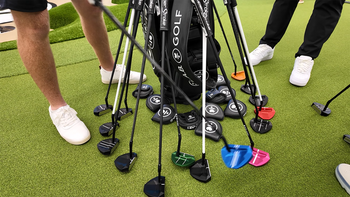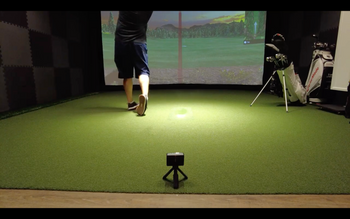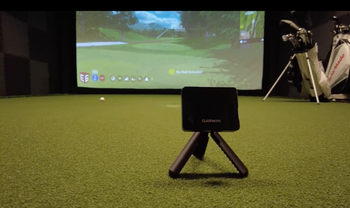You know what nobody talks about when setting up their home simulator? Getting your impact screen tight enough. Our equipment expert Marc just dropped some knowledge on this, and trust me, you'll want to nail this part of your setup.
Here's the thing - most folks obsess over which launch monitor to buy or what projector gives the sharpest image. But they totally whiff on screen tension. And that's where things can go sideways fast.
When you've dialed in the proper tightness, magic happens. Your projected course looks crisp and clean - no weird bulges or sagging that make Augusta National look like a fun house mirror. Plus, the ball actually rolls back toward your feet instead of shooting off like you're playing pinball. Oh, and it's way quieter too. Your neighbors will appreciate that when you're grinding on your swing at 10 PM.
But man, when that screen's too loose? You're in for a world of hurt. Picture this: you pure a 7-iron, feeling good about yourself, then BAM - the ball rockets back at your face because the screen's got more give than a trampoline. Your gorgeous Pebble Beach simulation looks warped. And the noise? It's like hitting shots inside a bass drum.
We're not just talking about a crappy practice session here. A floppy screen turns your man cave into a danger zone. Those ricochets aren't messing around - they'll find you, your TV, or that beer you just opened. Safety glasses become mandatory equipment, which kinda kills the whole "relaxing golf at home" vibe you're going for.
The bottom line? Proper screen tension transforms your simulator from a glorified driving range net into a legit practice facility. You'll actually enjoy your sessions instead of ducking for cover after every shot.
Reducing Bounce Back for a Safer Golf Simulator Setup

You know what's worse than chunking a shot on the range? Having your brand new simulator turn into a golf ball cannon that fires shots right back at your face. Trust me, I've been there, and it's not pretty.
Setting up your impact screen wrong creates a nightmare scenario. You'll spend more time dodging rebounds than working on your swing. Plus, crawling around on your hands and knees hunting for balls that rocketed to every corner of your garage? Yeah, that gets old fast.
Here's the deal - when you stretch that screen tighter than your back after 36 holes, you've basically built yourself a golf ball trampoline. The ball smacks it and comes flying back like it's seeking revenge for that last slice.
So what's the sweet spot for screen tension? Picture this: when you absolutely crush one with your driver, the ball should gently drop about 1 to 3 feet from the screen. That's it. No dramatic bounces, no dangerous projectiles.
Think about your setup for a second. With that gentle bounce and a natural roll, the ball typically ends up right around your feet - perfect for grabbing and teeing up your next shot. It's like having your own personal ball return system that actually works without trying to take your head off.
The key is finding that Goldilocks zone where the screen absorbs enough energy to keep you safe but still lets the ball drop naturally. Too loose and you'll damage the screen. Too tight and you're playing dodgeball instead of golf.
Avoiding Pitfalls: Top Mistakes When Installing Golf Impact Screens
You've measured your room for that new simulator setup and figured you can squeeze the screen right against the back wall? Hold up – that's gonna cause problems.
Here's the deal: your golf ball needs somewhere to go after smacking into that screen. We're talking about creating the perfect 1-to-3-foot bounce that rolls the ball right back to your feet. Get it wrong, and you'll either have balls ricocheting like pinballs or dead-dropping where you can't reach 'em.
First up – give yourself breathing room. Your impact screen needs at least 12 inches of space between it and whatever wall's behind it. When you crush a drive at 90+ mph and that ball rebounds off both the screen AND the wall? That's how you end up dodging golf balls like you're in some weird dodgeball game. Plus, your drywall's gonna look like Swiss cheese after a few sessions.
Now let's talk about your floor situation. Got a concrete garage floor? Yeah, that's basically a trampoline for golf balls. Picture this: ball hits screen, drops onto concrete, and suddenly you're playing ping-pong with a Titleist. Not ideal when you're trying to groove your swing.
The fix is simple – throw down some carpet or better yet, get yourself some quality hitting turf. Pick the right stuff and you've got a putting surface too. Nothing beats draining a few putts between crushing drives, right?
Distance matters too. You want at least 10 feet between your hitting position and that screen. Sure, some guys try to cheat this and stand closer, but trust me – when that Pro V1 comes screaming back at your shins, you'll wish you'd listened.
With proper spacing, here's what happens: you stripe one down the middle, it kisses the screen, bounces back those perfect 1-to-3 feet, hits your soft flooring, and rolls gently back toward your feet. Just hook it with your 7-iron and tee up the next one. No bending, no chasing balls around the room.
For those running radar-based launch monitors, you're looking at needing even more room – sometimes up to 21 feet total. That's because the radar box sits way behind you, plus you still need all that safety space we talked about. Check out the Golfers Authority blog for the full breakdown on launch monitor spacing if you're going that route.
Bottom line? Don't try to cram your simulator into a space that's too tight. Give yourself room to breathe, protect your walls (and shins), and create that perfect ball return system. Your back will thank you after a two-hour range session when you haven't bent over once to grab a ball.
Fine-Tuning Your Impact Screen for Peak Performance
Getting your impact screen tension dialed in might take some tinkering at first. You're shooting for that sweet spot where the ball bounces back about 1 to 3 feet - not too much, not too little.
Here's the thing though - you can skip all that guesswork with the right setup. The Golfers Authority SimStudio takes care of this headache for you. Everything's engineered to work together right out of the box, so you won't waste time messing around with tension adjustments.
The SimStudio uses a smart velcro system that connects your screen to the frame. It's already set up to give you the perfect amount of give when you stripe one down the middle (or shank it into the heel - we've all been there). The velcro runs around the edges, and if you need to tweak things just a hair, you can adjust how tight you stick it down.
Now, if you're looking at other setups that use bungee cords and metal eyelets, that's a different animal. These systems work fine, but you'll probably need to experiment more. Got too much tension making the screen drum-tight? Just unhook a few bungees until you find that Goldilocks zone.
Here's my advice - don't get bent out of shape if your first setup isn't perfect. Grab your 7-iron and hit a bucket's worth of balls. Watch how far they bounce back. Check if your projected image looks crisp without any weird wrinkles or sagging. Listen to how loud each impact sounds. Then make your adjustments from there.
The payoff's worth it when you nail the setup. You'll get cleaner ball flight data, your neighbors won't hate you for the noise, and you won't have balls ricocheting back at your shins. Trust me, taking 20 minutes to get this right beats dealing with a wonky screen every time you practice.

Simplify Your Setup with SimStudio Solutions
You've got tons of choices when it comes to setting up a golf simulator screen, and yeah, you can totally go the DIY route if you're feeling ambitious.
SimStudios makes it pretty sweet with their different packages. Want the whole nine yards? Grab a package with a launch monitor and you're getting the complete deal - your enclosure, impact screen, hitting mat, projector, side barriers, even a ball tray to keep those range balls from rolling all over your garage.
Not ready to drop cash on a launch monitor yet? No worries - they've got packages without one too. Heck, you can just snag the enclosure and screen if that's all you need right now.
Here's what really sells me on SimStudio though - the setup isn't going to make you want to throw your 7-iron through the wall. Everything clicks together like it should, and they size the screen to fit whatever enclosure you pick. Grab your buddy who helped install your TV mount, and you'll be hitting balls by dinner time. Seriously, it's that straightforward.
Whatever route you take, here's the deal - getting that impact screen tension dialed in is huge. Too loose and you'll get weird bounces that'll mess with your feedback. Too tight and you might damage it faster than you'd like. Nail that tension though, and you're golden for getting the most out of your home setup.
Conclusion
Look, getting your impact screen tension right isn't just some technical detail - it's the difference between loving your simulator and dreading every practice session. When you nail that sweet spot where balls drop 1-3 feet and roll back to your feet, you've basically built yourself a personal driving range that's safer than most public ones. Whether you go DIY or grab something like the SimStudio that's already dialed in, taking the time to get this right means you'll actually use your simulator instead of letting it collect dust. Trust me, your back, your TV, and your golf game will all thank you for putting in the effort upfront.





